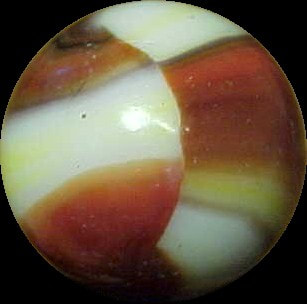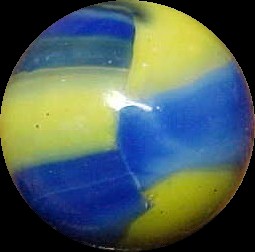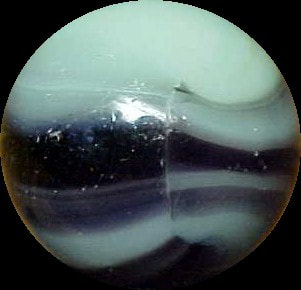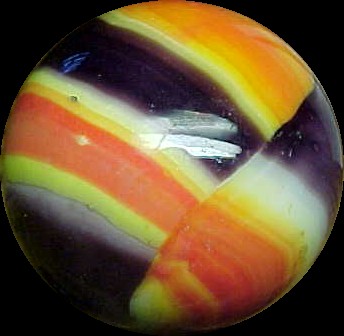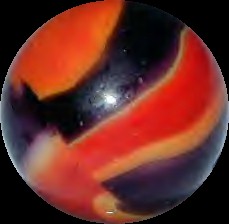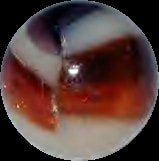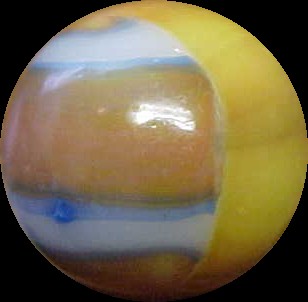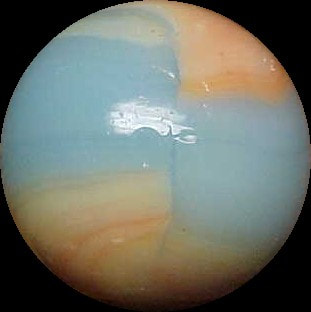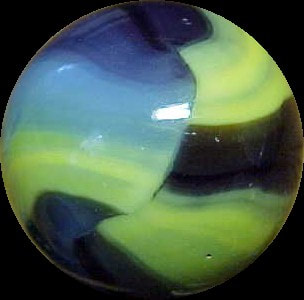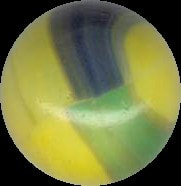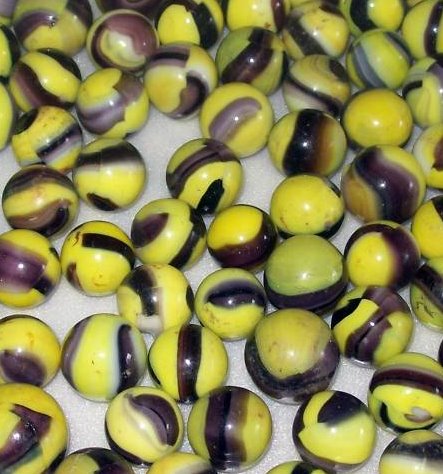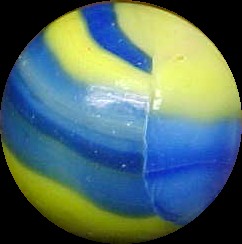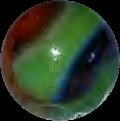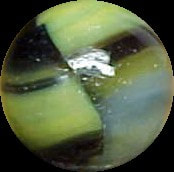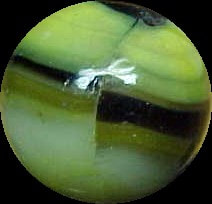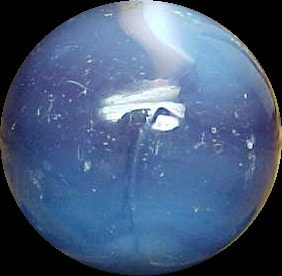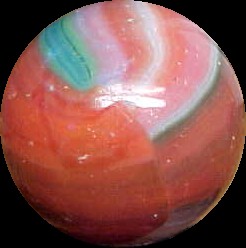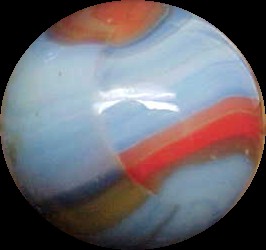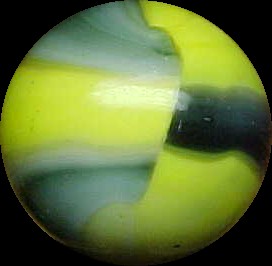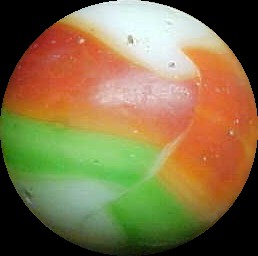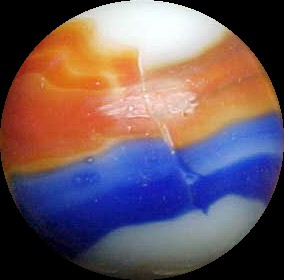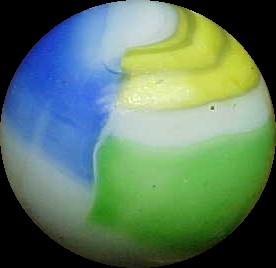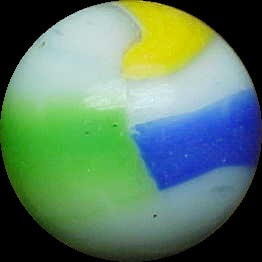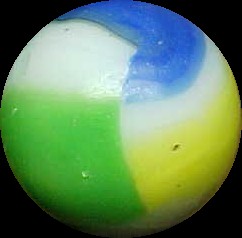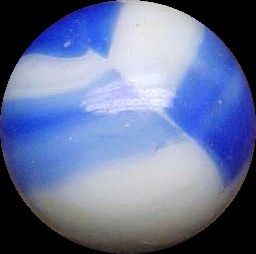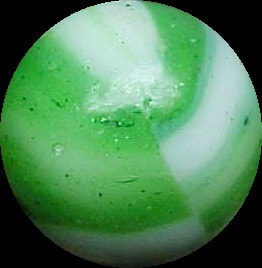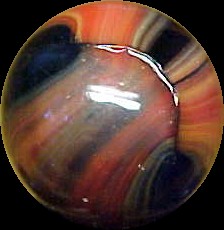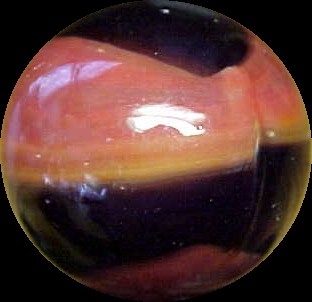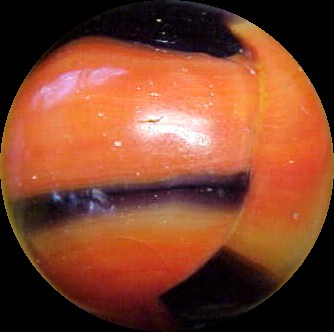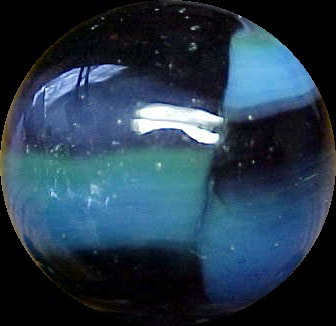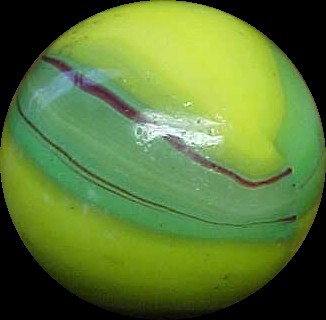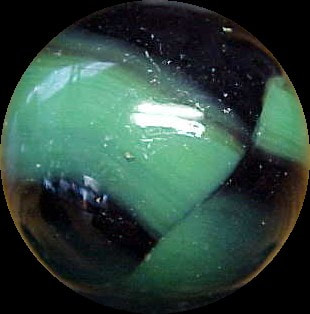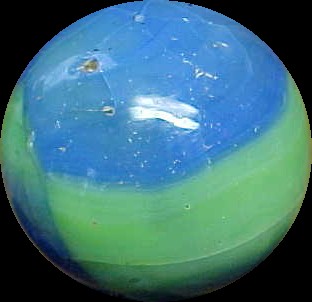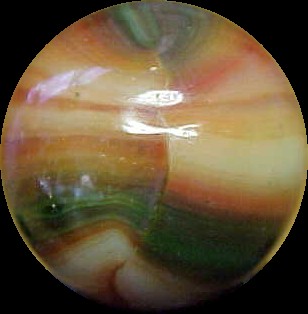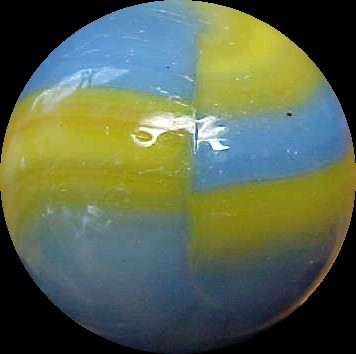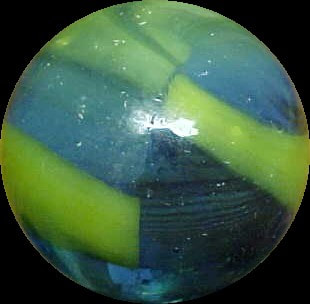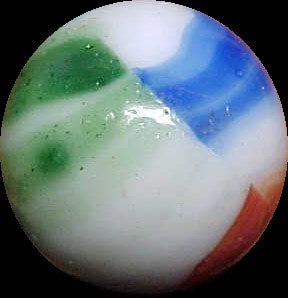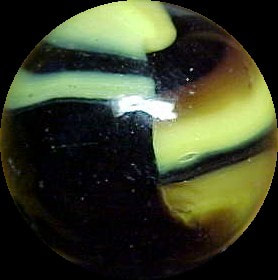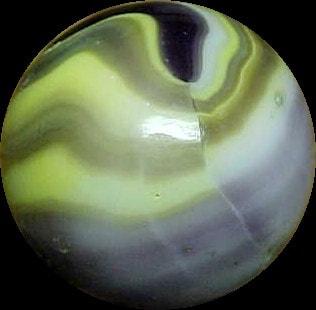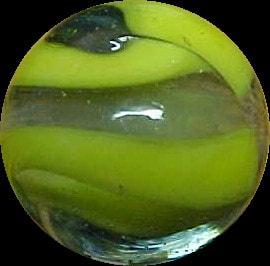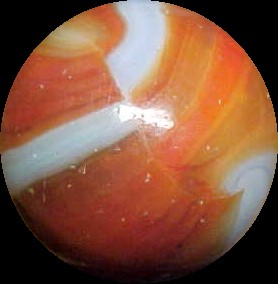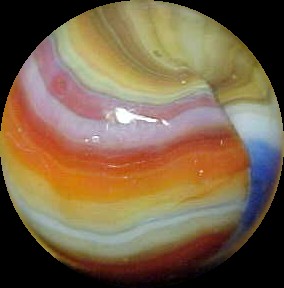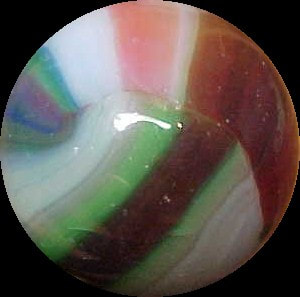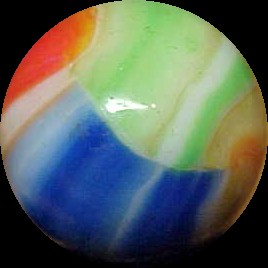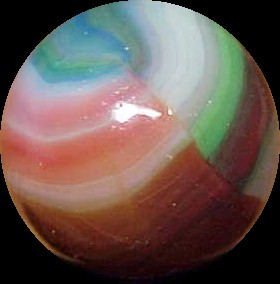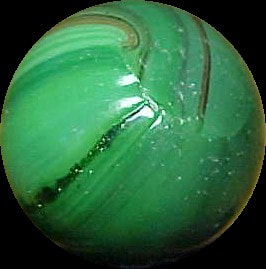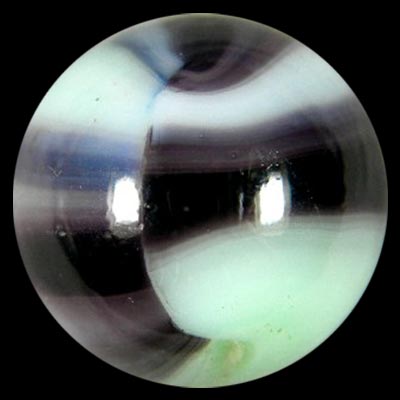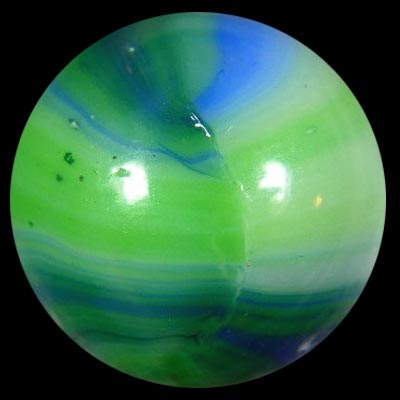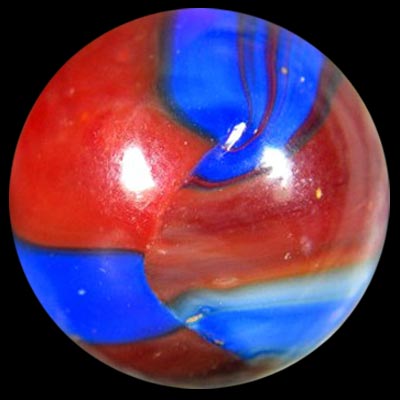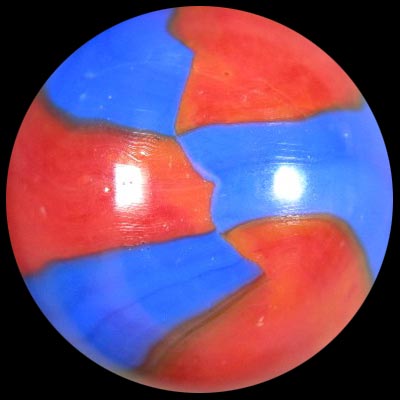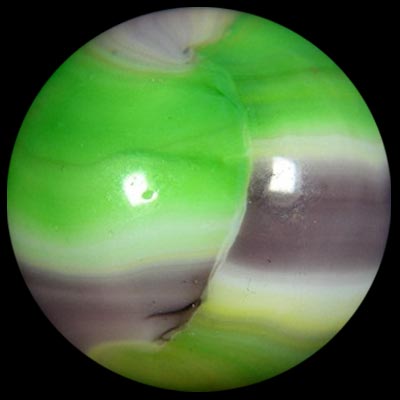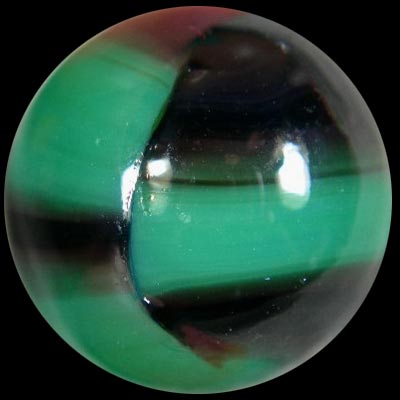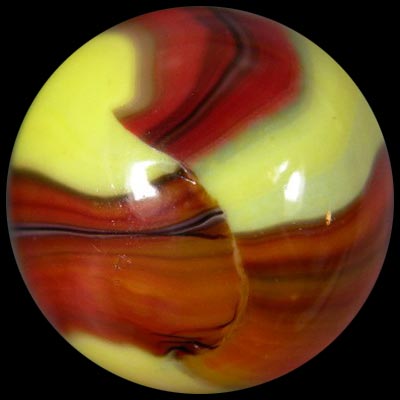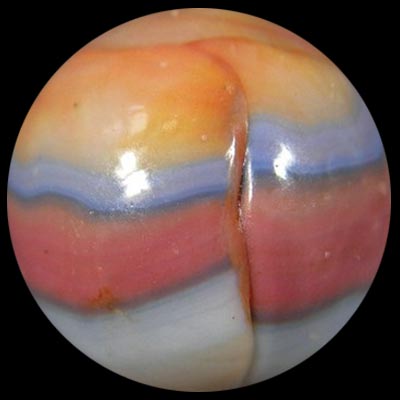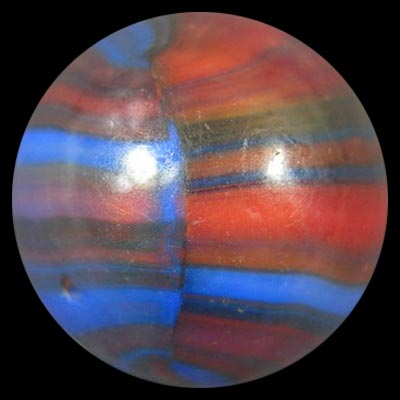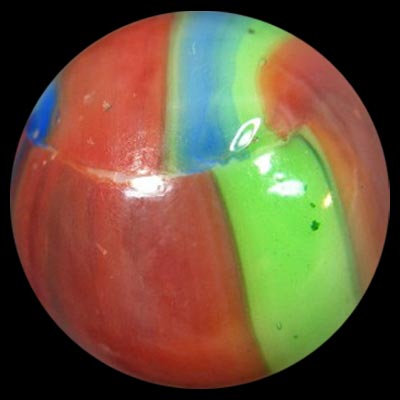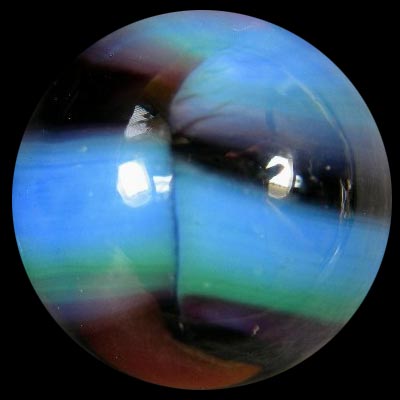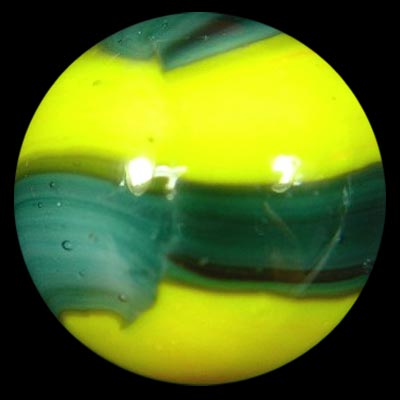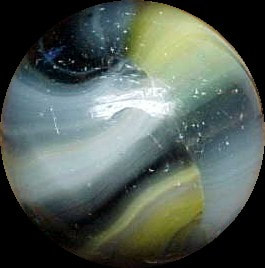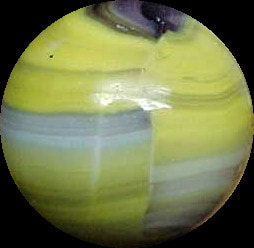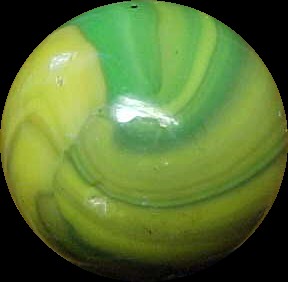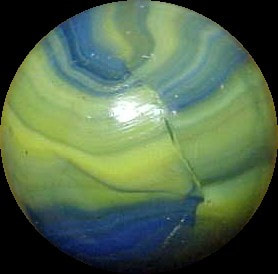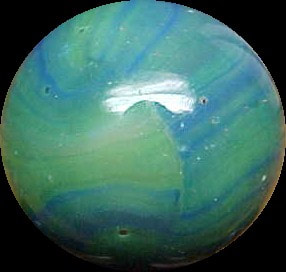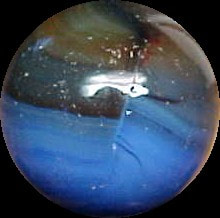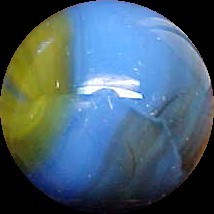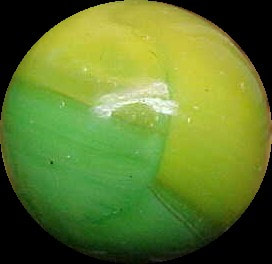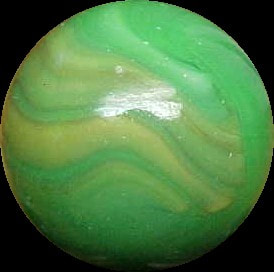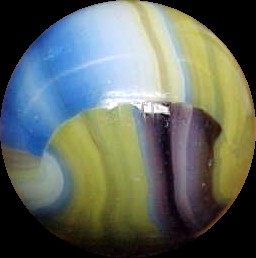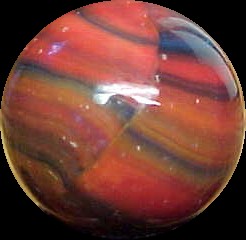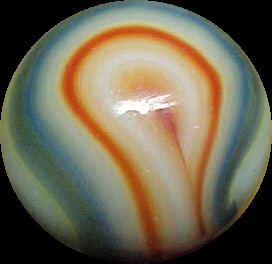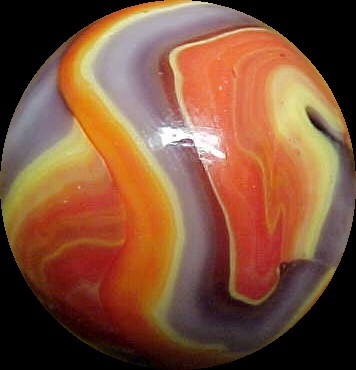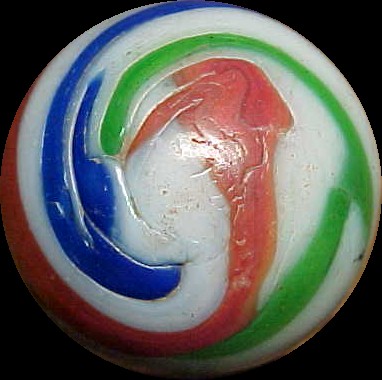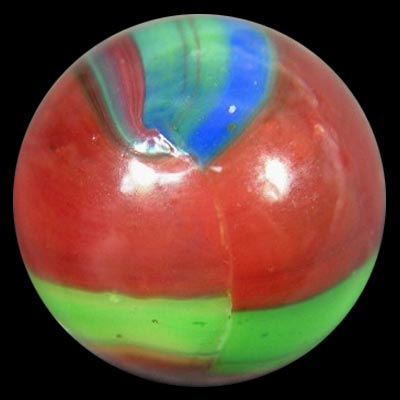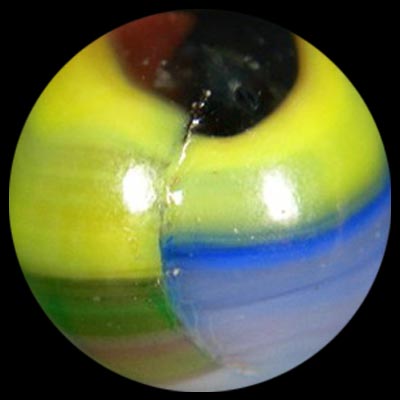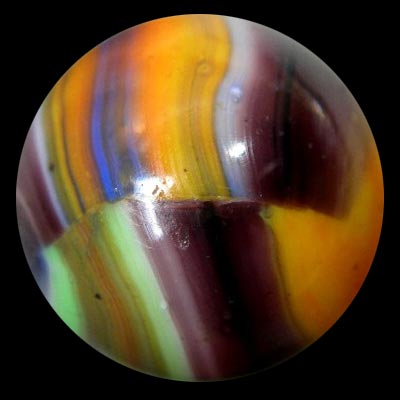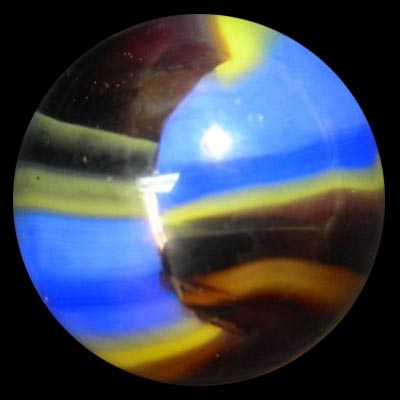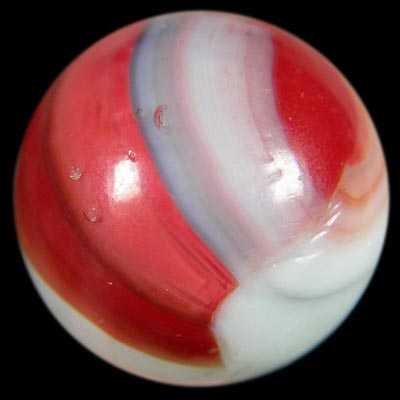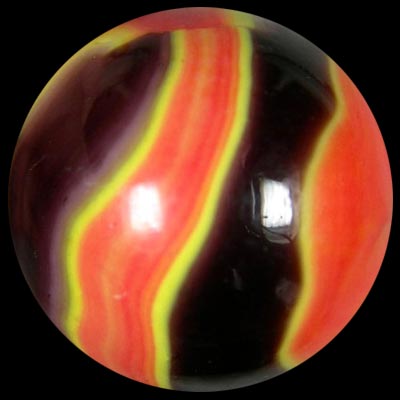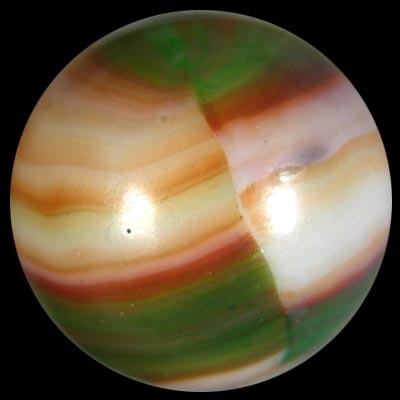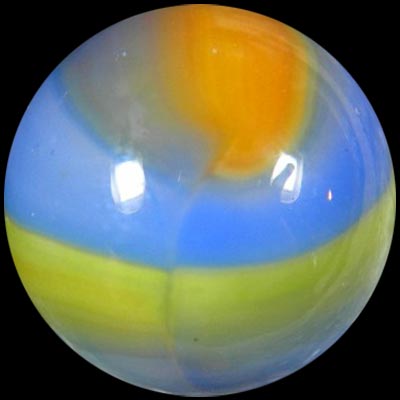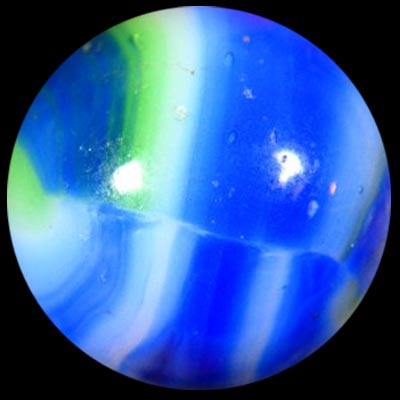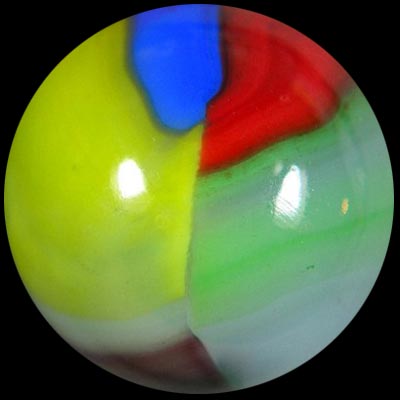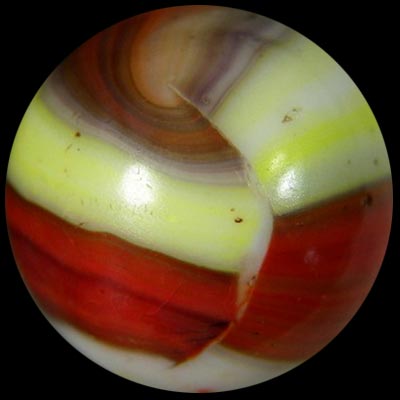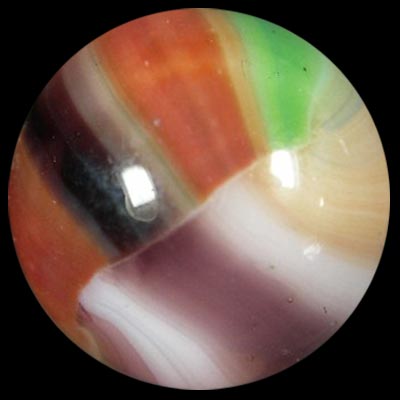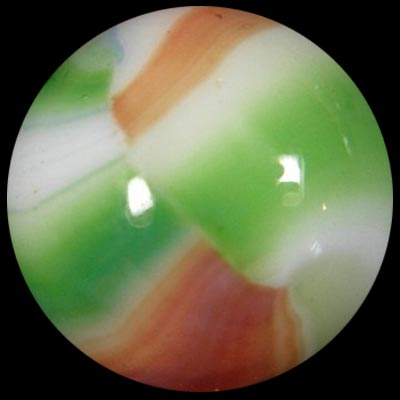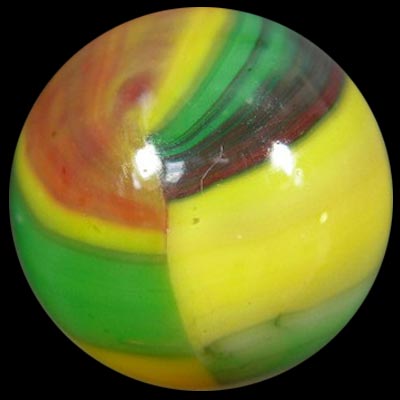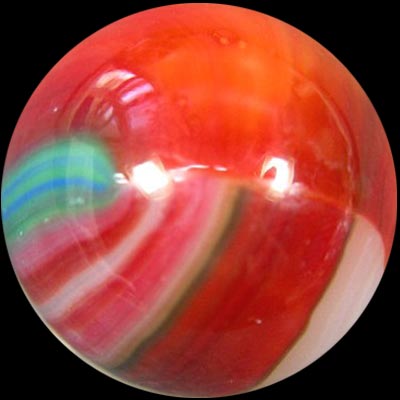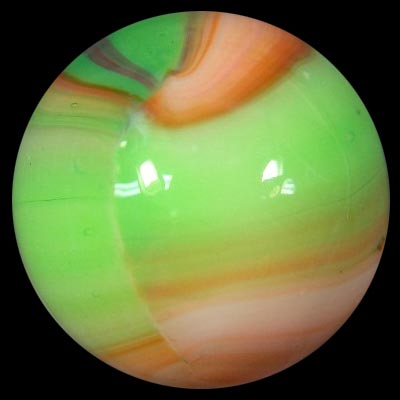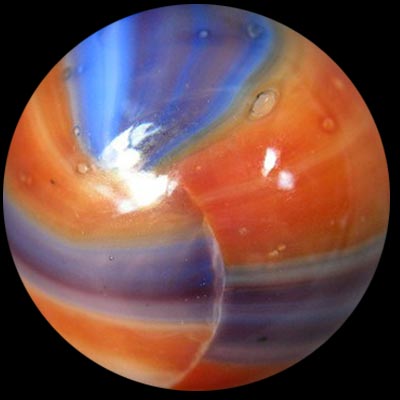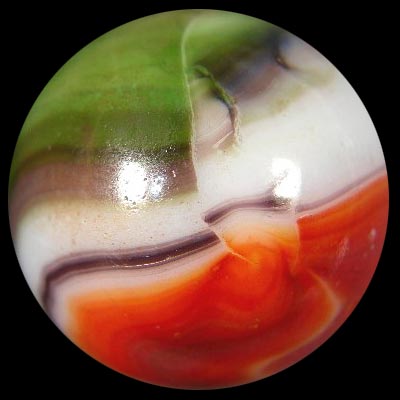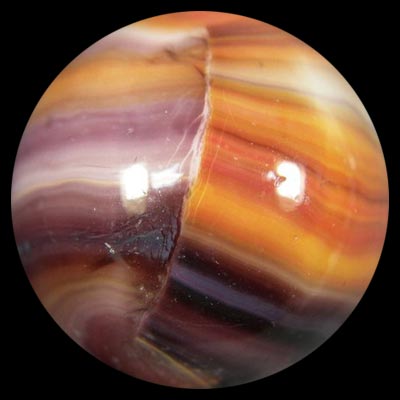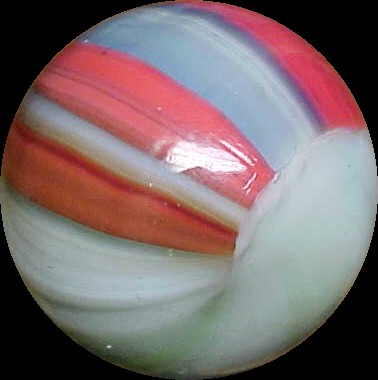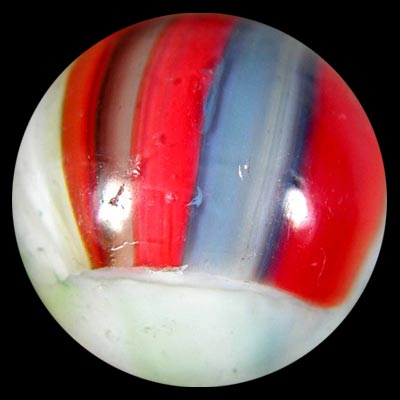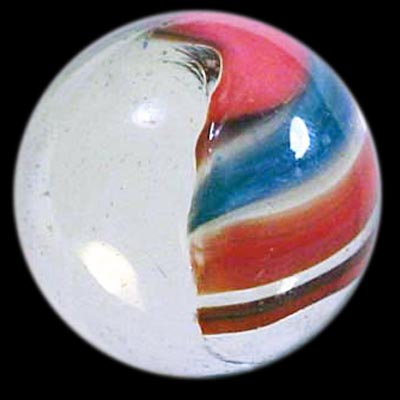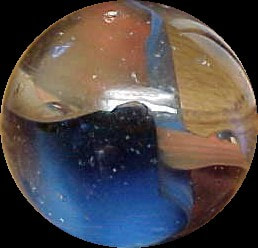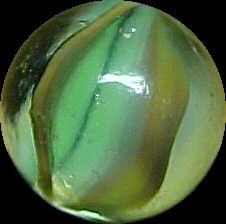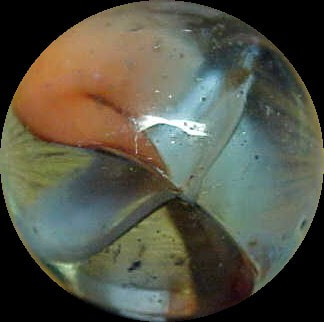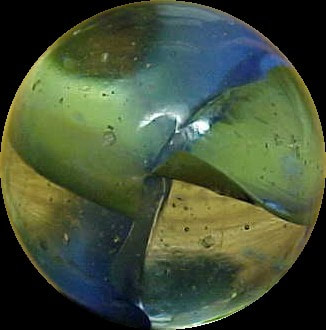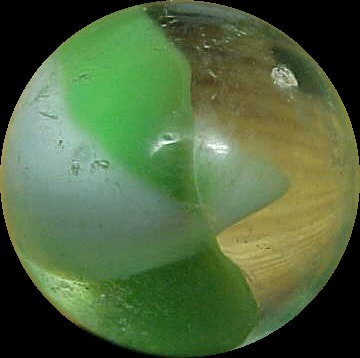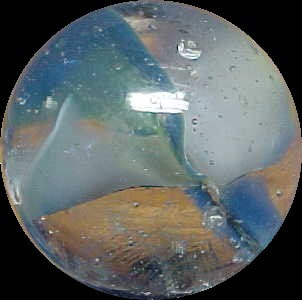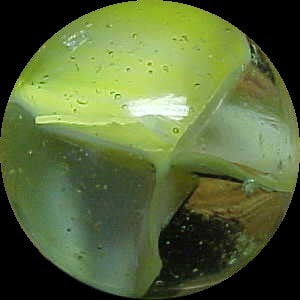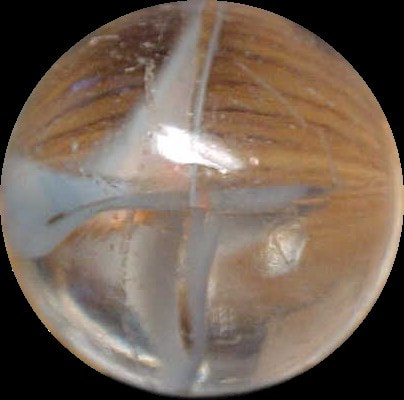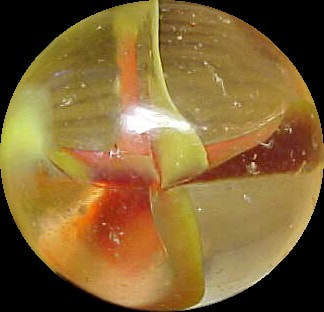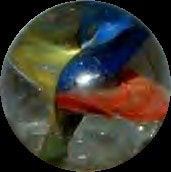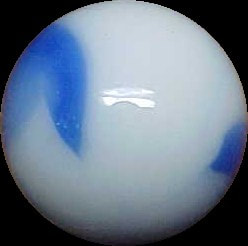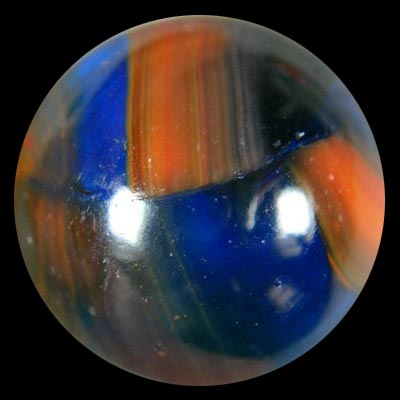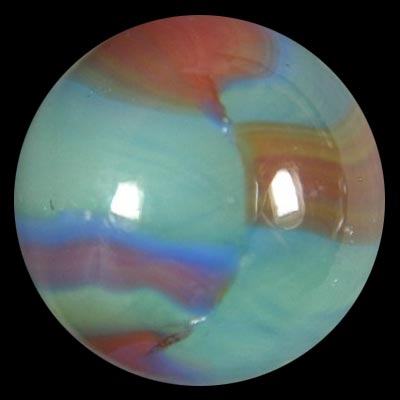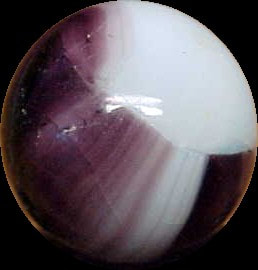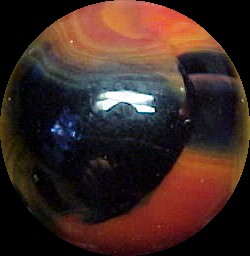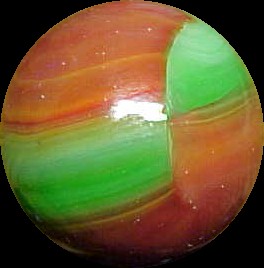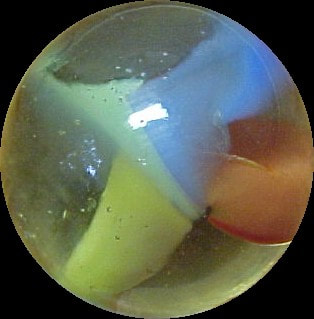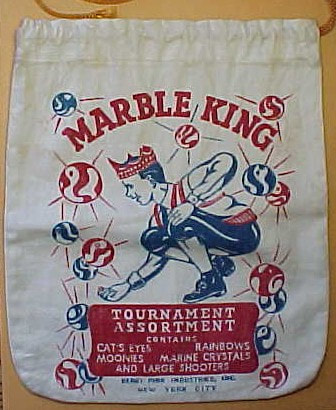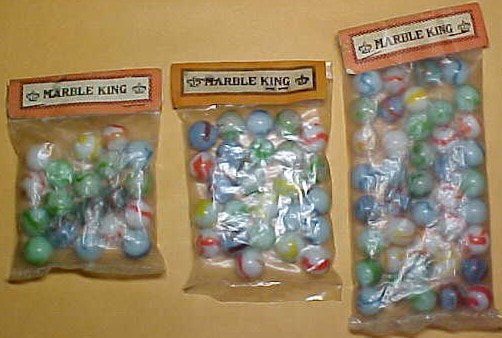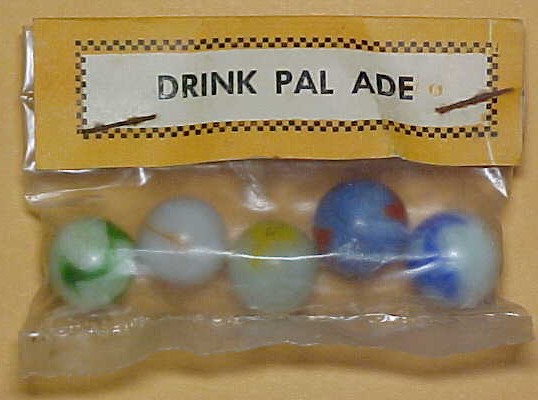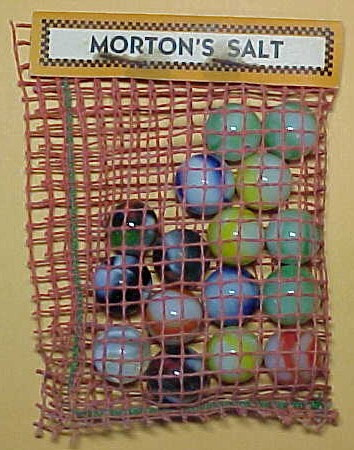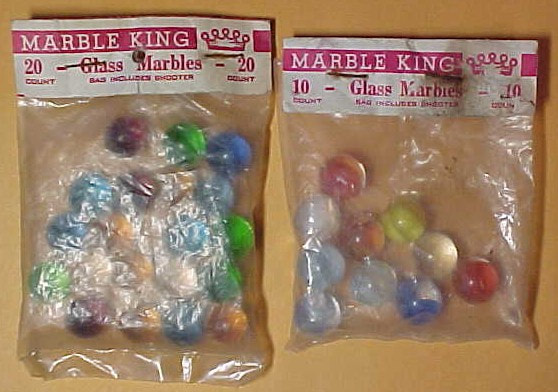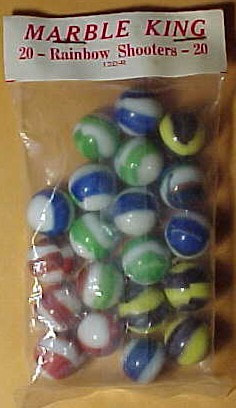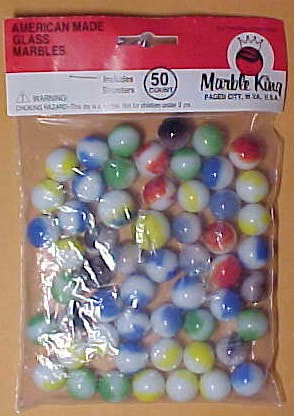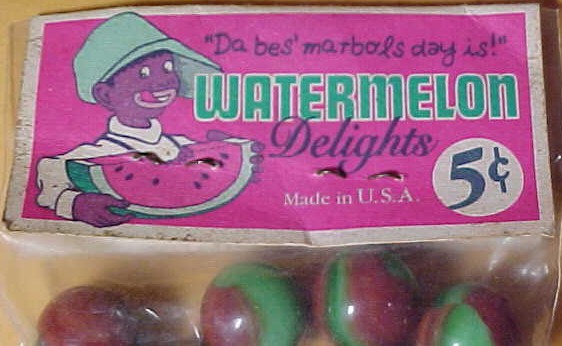MARBLE KING, INC. (1949-PRESENT)
COMPANY HISTORY
Though a relatively late starter, Marble King, Inc. quickly became a major force in the realm of American marble manufacturers. It actually began more than a decade earlier as the Alley Agate company (see Alley Agate page), but was sold by Lawrence Alley to Berry Pink and Sellers Peltier in 1949. The name was changed to Marble King and operated in St. Marys, West Virginia, until 1958, when it was destroyed by a fire. That same year the factory was rebuilt in Paden City, West Virginia, not too many miles north of St. Marys. The factory is still in operation today.
Berry Pink was no stranger to the world of marbles. For years, he had been a prominent promoter of the game of marbles (he had sponsored tournaments since 1922) and had even "jobbered" those of other companies under the name of "Berry Pink, Inc." since the 1920s. As owner of 51% of the company (Sellers, co-owner of Peltier Glass, possessed the remaining 49%), Pink was in charge of the company. However, he was based in New York City and for the most part trusted operations of his plant to Roger Howdyshell.
For the first several months Marble King did not manufacture marbles, though they had purchased Alley's machinery along with the factory, but rather packaged and sold marbles made by Peltier Glass. The initial production runs were in July, 1949. However, for many years following marbles by Peltier, as well as such other companies as Heaton Agate, were sold inside Marble King packaging.
The mid-1950s witnessed the introduction of catseye marbles from Japan to the American market, an event that crippled the U.S. marble manufacturers and even sent some out of business. In an effort to battle this blow, Pinky, Howdyshell, and Duncan Peltier (son of Sellers) traveled to Japan in order to purchase the machinery necessary for producing catseye marbles. Negotiations failed, but not before they managed to learn how to copy Japanese techniques. In 1955 Marble King introduced its own line of catseye marbles, which enabled the company to survive.
Earlier methods to reduce costs and keep the company profitable included a technique called "veneering," which was reportedly developed by Howdyshell. By this method, white-based glass was covered with colored glass, which was much less expensive than using colored glass for the base. Marble King was sold to Howdyshell, Duncan Peltier, and Cornell Medley in 1963. Howdyshell emerged in 1983 as the company's sole owner. He died in 1991 after 42 years with the company; he was succeeded as president of Marble King, Inc. by his wife, Jean.
Though a relatively late starter, Marble King, Inc. quickly became a major force in the realm of American marble manufacturers. It actually began more than a decade earlier as the Alley Agate company (see Alley Agate page), but was sold by Lawrence Alley to Berry Pink and Sellers Peltier in 1949. The name was changed to Marble King and operated in St. Marys, West Virginia, until 1958, when it was destroyed by a fire. That same year the factory was rebuilt in Paden City, West Virginia, not too many miles north of St. Marys. The factory is still in operation today.
Berry Pink was no stranger to the world of marbles. For years, he had been a prominent promoter of the game of marbles (he had sponsored tournaments since 1922) and had even "jobbered" those of other companies under the name of "Berry Pink, Inc." since the 1920s. As owner of 51% of the company (Sellers, co-owner of Peltier Glass, possessed the remaining 49%), Pink was in charge of the company. However, he was based in New York City and for the most part trusted operations of his plant to Roger Howdyshell.
For the first several months Marble King did not manufacture marbles, though they had purchased Alley's machinery along with the factory, but rather packaged and sold marbles made by Peltier Glass. The initial production runs were in July, 1949. However, for many years following marbles by Peltier, as well as such other companies as Heaton Agate, were sold inside Marble King packaging.
The mid-1950s witnessed the introduction of catseye marbles from Japan to the American market, an event that crippled the U.S. marble manufacturers and even sent some out of business. In an effort to battle this blow, Pinky, Howdyshell, and Duncan Peltier (son of Sellers) traveled to Japan in order to purchase the machinery necessary for producing catseye marbles. Negotiations failed, but not before they managed to learn how to copy Japanese techniques. In 1955 Marble King introduced its own line of catseye marbles, which enabled the company to survive.
Earlier methods to reduce costs and keep the company profitable included a technique called "veneering," which was reportedly developed by Howdyshell. By this method, white-based glass was covered with colored glass, which was much less expensive than using colored glass for the base. Marble King was sold to Howdyshell, Duncan Peltier, and Cornell Medley in 1963. Howdyshell emerged in 1983 as the company's sole owner. He died in 1991 after 42 years with the company; he was succeeded as president of Marble King, Inc. by his wife, Jean.
IDENTIFICATION TIPS
Like most companies, Marble King, Inc. produced a variety of solid color opaque and transparent marbles, as well as swirls, that are for all intents and purposes indistinguishable from those of their contemporaries. They did, however, create a number of styles which are unique to the company.
RAINBOWS
Rainbows, which are sometimes referred to as "patch and ribbons," are easily identifiable, though some have been mistaken for Type Five National Line Rainbos (see Peltier page). These marbles are typically two-colored; one one pole have a patch of one color, with a ribbon of another color encircling the equator and then another ribbon of the original color paralleling it, and finally a patch of the second color on the opposite pole. On opposite side of the marble will be arc-shaped seams.
The bulk of Rainbows have a white base with a colored patch and ribbon veneered on it. Other Rainbows will also be white-based, though they are covered with two different veneered colors. Sometimes a bit of the underlying white glass will show through, however.
Two color Rainbows have been assigned a number of names by the children who once played with them, and also by later collectors (many of whom were once the children). In approximate order of increasing rarity, the marbles are known as Bumblebees (yellow and black or dark purple), Gray Bees (yellow and gray), Wasps (red and black or dark purple), Boyscouts (a.k.a. Cub Scouts) (blue and yellow), Girlscouts (green and yellow), Tigers (orange and black), Ruby Bees (red and yellow), Spiderman (red and blue), Hercules (blue and black or dark purple), Green Hornets (green and black), Watermelons (red and green), and Dragonflies (green and blue). Hybrid examples are known (see below).
Thin lines of oxblood are sometimes found on the green ribbons and patches of Rainbows. This is most often seen on Girlscouts and Watermelons. This increases the value of the marble in many cases, though it should be noted that most genuine Watermelons seem to have this feature. Aventurine is also found at times on the green; on color-based Rainbows it may occur along with oxblood, while on white-based examples it does not. Aventurine green on white Rainbows have been called Grasshoppers.
It is important to emphasize that the best color-based Rainbows will have bright colors with well-defined patches and ribbons. Also, new collectors should be aware that in recent years the company has released a series of marbles that somewhat resemble the older Rainbows. There are several differences that should be taken into account. First, the base is translucent, not white with a colored veneer. Second, the pattern is patch/ribbon/patch, not patch/ribbon/ribbon/patch. Third, these marbles, always of one color combination, are often placed into reproduced polyvinyl bags by con artists. Original Marble King packages never contained all of one combination of colors. The most common of these new marbles superficially resemble Watermelons and were called "Ninja Turtles" by the company.
RAINBOW REDS, TRICOLOR RAINBOWS, MULTICOLOR RAINBOWS & VARICOLOR RAINBOWS
There are four variations of Rainbows that are worthy of mention. The first of these is the Rainbow Red, so named by the company; these do not have patches but rather are white-based with two equatorial colored ribbons, one of which will always be red. These are common and have little value to collectors.
The second variation is the Tricolor Rainbow; these are white-based and usually have a lot of white showing through. On one pole there is a patch of one color, and encircling the equator are two different colored ribbons. One of the ribbons runs from seam to seam, so that it encircles half of the marble. Opposite this there will be a third color which also runs from seam to seam but on the other half of the marble. These are fairly common. More rarely, examples will be found with aventurine.
The third variation of the Rainbow is the Multicolor Rainbow, which is fairly scarce. This marble possesses a white base, with very little or a lot of the white showing through between the patches and ribbons. This marble resembles the pattern seen in regular Rainbows, but the two equatorial ribbons will be different colors than the patches, which also are differently colored than one another. There is also a seven-color variety that is often ascribed to Marble King but which more recently is being debated as possibly Vitro Agate.
The fourth variation is the Varicolored Rainbow, the name of which I have dubbed here to differentiate it from Multicolored Rainbows. This is actually a hybrid type and as far as I know has only originated from the Paden City dump sites. This marble can have as many as seven colors in addition to the white. The factor separating it from the Seven-Color Patch mentioned above is that the colors are usually blended and not as sharp as on the latter type.
Like most companies, Marble King, Inc. produced a variety of solid color opaque and transparent marbles, as well as swirls, that are for all intents and purposes indistinguishable from those of their contemporaries. They did, however, create a number of styles which are unique to the company.
RAINBOWS
Rainbows, which are sometimes referred to as "patch and ribbons," are easily identifiable, though some have been mistaken for Type Five National Line Rainbos (see Peltier page). These marbles are typically two-colored; one one pole have a patch of one color, with a ribbon of another color encircling the equator and then another ribbon of the original color paralleling it, and finally a patch of the second color on the opposite pole. On opposite side of the marble will be arc-shaped seams.
The bulk of Rainbows have a white base with a colored patch and ribbon veneered on it. Other Rainbows will also be white-based, though they are covered with two different veneered colors. Sometimes a bit of the underlying white glass will show through, however.
Two color Rainbows have been assigned a number of names by the children who once played with them, and also by later collectors (many of whom were once the children). In approximate order of increasing rarity, the marbles are known as Bumblebees (yellow and black or dark purple), Gray Bees (yellow and gray), Wasps (red and black or dark purple), Boyscouts (a.k.a. Cub Scouts) (blue and yellow), Girlscouts (green and yellow), Tigers (orange and black), Ruby Bees (red and yellow), Spiderman (red and blue), Hercules (blue and black or dark purple), Green Hornets (green and black), Watermelons (red and green), and Dragonflies (green and blue). Hybrid examples are known (see below).
Thin lines of oxblood are sometimes found on the green ribbons and patches of Rainbows. This is most often seen on Girlscouts and Watermelons. This increases the value of the marble in many cases, though it should be noted that most genuine Watermelons seem to have this feature. Aventurine is also found at times on the green; on color-based Rainbows it may occur along with oxblood, while on white-based examples it does not. Aventurine green on white Rainbows have been called Grasshoppers.
It is important to emphasize that the best color-based Rainbows will have bright colors with well-defined patches and ribbons. Also, new collectors should be aware that in recent years the company has released a series of marbles that somewhat resemble the older Rainbows. There are several differences that should be taken into account. First, the base is translucent, not white with a colored veneer. Second, the pattern is patch/ribbon/patch, not patch/ribbon/ribbon/patch. Third, these marbles, always of one color combination, are often placed into reproduced polyvinyl bags by con artists. Original Marble King packages never contained all of one combination of colors. The most common of these new marbles superficially resemble Watermelons and were called "Ninja Turtles" by the company.
RAINBOW REDS, TRICOLOR RAINBOWS, MULTICOLOR RAINBOWS & VARICOLOR RAINBOWS
There are four variations of Rainbows that are worthy of mention. The first of these is the Rainbow Red, so named by the company; these do not have patches but rather are white-based with two equatorial colored ribbons, one of which will always be red. These are common and have little value to collectors.
The second variation is the Tricolor Rainbow; these are white-based and usually have a lot of white showing through. On one pole there is a patch of one color, and encircling the equator are two different colored ribbons. One of the ribbons runs from seam to seam, so that it encircles half of the marble. Opposite this there will be a third color which also runs from seam to seam but on the other half of the marble. These are fairly common. More rarely, examples will be found with aventurine.
The third variation of the Rainbow is the Multicolor Rainbow, which is fairly scarce. This marble possesses a white base, with very little or a lot of the white showing through between the patches and ribbons. This marble resembles the pattern seen in regular Rainbows, but the two equatorial ribbons will be different colors than the patches, which also are differently colored than one another. There is also a seven-color variety that is often ascribed to Marble King but which more recently is being debated as possibly Vitro Agate.
The fourth variation is the Varicolored Rainbow, the name of which I have dubbed here to differentiate it from Multicolored Rainbows. This is actually a hybrid type and as far as I know has only originated from the Paden City dump sites. This marble can have as many as seven colors in addition to the white. The factor separating it from the Seven-Color Patch mentioned above is that the colors are usually blended and not as sharp as on the latter type.
RAINBOWS GALLERY
(Hover your mouse or lightly touch the image to see the type of marble. Click to view the full size image)
(Hover your mouse or lightly touch the image to see the type of marble. Click to view the full size image)
HYBRID RAINBOWS, BLENDED RAINBOWS, EXPERIMENTALS & OTHERS
In the last few years there has been an influx of Marble King marbles that previously were either very rare or had indeed never been seen before. Many of these owe their appearance to the fact that several old dump sites used by Marble King in the late 1950s and early 1960s near their Paden City plant have been discovered and are continuously being excavated. While some of the "hybrid" types remain rare, others, especially the "blended" types, have been found in such numbers that their value has dropped to sometimes a tenth of what was paid not a year previous. Though sometimes regarded as "rejects" by a few collectors, many of these marbles are beautiful and extremely rare.
Some of the styles that have been recognized for quite a while include Rainbow hybrids which have three or four colors instead of two. Two such types include the "Spidermelon," which has the colors of a Spiderman and a Watermelon, and what has been jokingly referred to by some collectors as a "Hermaphrodite ," a marble that contains the colors of both the Boyscout and Girlscout. There is also the Bengal Tiger, which has a black and yellow base like a Bumblebee, but with orange on top of the yellow. Other errant Rainbows are patches, many of which basically have connecting polar patches in the absence of equatorial ribbons.
Blended Rainbows are those, that for some reason, did not come out as separately colored patch and ribbon styles but rather are veneered with fine striations of the separate colors, which often have blended together to form a multicolored effect. For example, a Blended Spiderman contains blue, red, and purple striations, the latter color having formed where the other two mixed together. Other Blended Rainbows include Bumblebees, Boyscouts, Girlscouts, Green Hornets, and Dragonflies. The colors on some are more muted than they would be on true Rainbows. Hybrid examples also occur rarely. It is unclear whether or not such marbles were accidentally made and then discarded, or were purposefully made as an experiment but for one reason or another rejected. What is clear is that significant numbers of these striking marbles have been dug up, though for the most part they remain scarce.
Some blended types which appear to have never been distributed, but which are coming out of the Marble King dump sites, have very interesting and often beautiful color combinations. The Robin has a blended light blue and white base with a reddish brown patch on one pole and two opposing equatorial ribbons: one light brown, usually trimmed with dark blue, and one bright red, usually trimmed by shades of brown. The Peacock has a blended red and white base with a bluish green and purple patch and ribbon. The Irish has a blended red and white base with a blue and green patch and ribbon. Other recently identified and named varieties include the "Jillian," "West Virginian" "Cookies and Cream," "Polar Bear," and "Copperhead." The list goes on.
Other marbles being unearthed in Paden City dump sites include odds and ends that never saw distribution in the marble market. For instance, peewee (less than 1/2") Bumblebees, Boyscouts, and Girlscouts, as well as hybrids, have been recovered. There are also Rainbows which have a light transparent blue base and yellow patch and ribbons; these have been dubbed "Blueboys" by the diggers. A variation of this marble is the "Clearboy," which has a colorless transparent base and yellow patch and ribbons. There is also a transparent blue-based Wasp. Another type is being called the Black Widow; it has a black base with two equatorial bands of red that do not touch.
Another great aspect of the Marble King dump sites is that they are producing a number of oddball types that represent discarded production errors. Some of these marbles are manifested as corkscrews. Others have "Christensen-like" turkey-swirls.
In the last few years there has been an influx of Marble King marbles that previously were either very rare or had indeed never been seen before. Many of these owe their appearance to the fact that several old dump sites used by Marble King in the late 1950s and early 1960s near their Paden City plant have been discovered and are continuously being excavated. While some of the "hybrid" types remain rare, others, especially the "blended" types, have been found in such numbers that their value has dropped to sometimes a tenth of what was paid not a year previous. Though sometimes regarded as "rejects" by a few collectors, many of these marbles are beautiful and extremely rare.
Some of the styles that have been recognized for quite a while include Rainbow hybrids which have three or four colors instead of two. Two such types include the "Spidermelon," which has the colors of a Spiderman and a Watermelon, and what has been jokingly referred to by some collectors as a "Hermaphrodite ," a marble that contains the colors of both the Boyscout and Girlscout. There is also the Bengal Tiger, which has a black and yellow base like a Bumblebee, but with orange on top of the yellow. Other errant Rainbows are patches, many of which basically have connecting polar patches in the absence of equatorial ribbons.
Blended Rainbows are those, that for some reason, did not come out as separately colored patch and ribbon styles but rather are veneered with fine striations of the separate colors, which often have blended together to form a multicolored effect. For example, a Blended Spiderman contains blue, red, and purple striations, the latter color having formed where the other two mixed together. Other Blended Rainbows include Bumblebees, Boyscouts, Girlscouts, Green Hornets, and Dragonflies. The colors on some are more muted than they would be on true Rainbows. Hybrid examples also occur rarely. It is unclear whether or not such marbles were accidentally made and then discarded, or were purposefully made as an experiment but for one reason or another rejected. What is clear is that significant numbers of these striking marbles have been dug up, though for the most part they remain scarce.
Some blended types which appear to have never been distributed, but which are coming out of the Marble King dump sites, have very interesting and often beautiful color combinations. The Robin has a blended light blue and white base with a reddish brown patch on one pole and two opposing equatorial ribbons: one light brown, usually trimmed with dark blue, and one bright red, usually trimmed by shades of brown. The Peacock has a blended red and white base with a bluish green and purple patch and ribbon. The Irish has a blended red and white base with a blue and green patch and ribbon. Other recently identified and named varieties include the "Jillian," "West Virginian" "Cookies and Cream," "Polar Bear," and "Copperhead." The list goes on.
Other marbles being unearthed in Paden City dump sites include odds and ends that never saw distribution in the marble market. For instance, peewee (less than 1/2") Bumblebees, Boyscouts, and Girlscouts, as well as hybrids, have been recovered. There are also Rainbows which have a light transparent blue base and yellow patch and ribbons; these have been dubbed "Blueboys" by the diggers. A variation of this marble is the "Clearboy," which has a colorless transparent base and yellow patch and ribbons. There is also a transparent blue-based Wasp. Another type is being called the Black Widow; it has a black base with two equatorial bands of red that do not touch.
Another great aspect of the Marble King dump sites is that they are producing a number of oddball types that represent discarded production errors. Some of these marbles are manifested as corkscrews. Others have "Christensen-like" turkey-swirls.
HYBRID RAINBOWS GALLERY
(Hover your mouse or lightly touch the image to see the type of marble. Click to view the full size image)
(Hover your mouse or lightly touch the image to see the type of marble. Click to view the full size image)
CATSEYES
As discussed earlier, Marble King was one of the first, if not the first, companies to produce its own line of Catseye marbles in an effort to compete with those being exported from Japan to the States. Since the company's design was copied from that of the Japanese, Marble King catseyes resemble those from Japan, at least more so than those of other American manufacturers. Marble King Catseyes have four intersecting vanes which meet in the center of the marble. Typically, the vanes are all the same color (white, red, blue, yellow, green, and orange), and the vanes are most often wavy, not straight. Many of them tend to be fluorescent.
One type of Marble King catseye is called the "St. Marys," as it appears that this marble was only produced at their plant location in the city of that name, and thus would have had to be made between 1955 and 1958. This marble is basically identical to the other catseyes described above, save that the vanes are of two or more colors. The most common are those that have two opposing vanes of one color intersected by two opposing vanes of another color. Color combinations include blue/yellow, yellow/white, blue/white, red/white, green/white, and red/blue. Some very rare St. Marys catseyes have four colors. Two color combinations are known: blue/red/yellow/green and blue/white/green/yellow. Again, hybrid examples are known among the St. Marys catseyes.
An additional catseye is called the "Signature Catseye." This is essentially a St. Marys type produced, it is thought, at the Paden City location. The Signature Catseye is identifiable by its orange and blue vanes. It tends to be larger than the earlier St. Marys catseyes.
Several more catseye marbles merit attention here. All are known only from the digs in Paden City. One has four vanes in "carnival" glass, which is an iridized yellowish orange color that has been sprayed onto the marble. The second type has a transparent ruby red base with a white banana-like blob of glass floating on the interior. Even more rarely, other colored bases occur. A third type is the Green-Blue Catseye, which has four fat green vanes, with a transparent blue vane floating over one of the green vanes. Finally, there is a peewee variety that measures between 5/16" and 13/32". These have been found in yellow, green, red, and blue and have four vanes; often, one or more of the vanes "float" on or near the surface of the marble. Some of these tiny marbles are hybrids, containing two or three colors.
A new 4-Color catseye put out by Marble King in 2000-2001 closely resembles the St. Mary's 4-color catseye and is going to fool some collectors. The marble, like the St. Mary's, has four vanes, one each of yellow, orange, blue, and green. However, these new versions seem to have lighter colors, especially the blue and green. Also, the green vanes appear to have diffuse edges which do not reach the exterior. Since these marbles can be had for around a dollar apiece (they are collectible I feel, so be sure to find one), and St. Mary's examples can fetch good prices, fraud and misrepresentation may well be a problem with these.
BERRY PINKS
The "Berry Pink" is a transparent-based two-seamed patch marble that only is found in the one inch size range. The base is almost completely filled with opaque white that has blue and green highlights. Covering about one third of the surface, and encircling half the marble's equator from seam to seam, is a patch with red and blue bands. These marbles are almost always fractured and are very rare.
As discussed earlier, Marble King was one of the first, if not the first, companies to produce its own line of Catseye marbles in an effort to compete with those being exported from Japan to the States. Since the company's design was copied from that of the Japanese, Marble King catseyes resemble those from Japan, at least more so than those of other American manufacturers. Marble King Catseyes have four intersecting vanes which meet in the center of the marble. Typically, the vanes are all the same color (white, red, blue, yellow, green, and orange), and the vanes are most often wavy, not straight. Many of them tend to be fluorescent.
One type of Marble King catseye is called the "St. Marys," as it appears that this marble was only produced at their plant location in the city of that name, and thus would have had to be made between 1955 and 1958. This marble is basically identical to the other catseyes described above, save that the vanes are of two or more colors. The most common are those that have two opposing vanes of one color intersected by two opposing vanes of another color. Color combinations include blue/yellow, yellow/white, blue/white, red/white, green/white, and red/blue. Some very rare St. Marys catseyes have four colors. Two color combinations are known: blue/red/yellow/green and blue/white/green/yellow. Again, hybrid examples are known among the St. Marys catseyes.
An additional catseye is called the "Signature Catseye." This is essentially a St. Marys type produced, it is thought, at the Paden City location. The Signature Catseye is identifiable by its orange and blue vanes. It tends to be larger than the earlier St. Marys catseyes.
Several more catseye marbles merit attention here. All are known only from the digs in Paden City. One has four vanes in "carnival" glass, which is an iridized yellowish orange color that has been sprayed onto the marble. The second type has a transparent ruby red base with a white banana-like blob of glass floating on the interior. Even more rarely, other colored bases occur. A third type is the Green-Blue Catseye, which has four fat green vanes, with a transparent blue vane floating over one of the green vanes. Finally, there is a peewee variety that measures between 5/16" and 13/32". These have been found in yellow, green, red, and blue and have four vanes; often, one or more of the vanes "float" on or near the surface of the marble. Some of these tiny marbles are hybrids, containing two or three colors.
A new 4-Color catseye put out by Marble King in 2000-2001 closely resembles the St. Mary's 4-color catseye and is going to fool some collectors. The marble, like the St. Mary's, has four vanes, one each of yellow, orange, blue, and green. However, these new versions seem to have lighter colors, especially the blue and green. Also, the green vanes appear to have diffuse edges which do not reach the exterior. Since these marbles can be had for around a dollar apiece (they are collectible I feel, so be sure to find one), and St. Mary's examples can fetch good prices, fraud and misrepresentation may well be a problem with these.
BERRY PINKS
The "Berry Pink" is a transparent-based two-seamed patch marble that only is found in the one inch size range. The base is almost completely filled with opaque white that has blue and green highlights. Covering about one third of the surface, and encircling half the marble's equator from seam to seam, is a patch with red and blue bands. These marbles are almost always fractured and are very rare.
CATSEYES GALLERY
(Hover your mouse or lightly touch the image to see the type of marble. Click to view the full size image)
(Hover your mouse or lightly touch the image to see the type of marble. Click to view the full size image)
MODERN MARBLE KING MARBLES
After 1975, Marble King ceased production of its true patch and ribbon Rainbows and switched over to a style that involved either two polar patches but no equatorial ribbons or a polar patch with an equatorial ribbon that covers only one side of the marble. These were all white-based with one color. In the mid 1990s Marble King produced a blended marble with colors of the old color-based Rainbows but on a transparent base. Later, in the later 1990s, they have also manufactured a series of new style color-based Rainbows with have patches of one color and ribbons of another, instead of possessing alternating colors. These were made to resemble such older styles as Wasps and Watermelons.
After 1975, Marble King ceased production of its true patch and ribbon Rainbows and switched over to a style that involved either two polar patches but no equatorial ribbons or a polar patch with an equatorial ribbon that covers only one side of the marble. These were all white-based with one color. In the mid 1990s Marble King produced a blended marble with colors of the old color-based Rainbows but on a transparent base. Later, in the later 1990s, they have also manufactured a series of new style color-based Rainbows with have patches of one color and ribbons of another, instead of possessing alternating colors. These were made to resemble such older styles as Wasps and Watermelons.
MODERN MARBLE KING MARBLES GALLERY
(Hover your mouse or lightly touch the image to see the type of marble. Click to view the full size image)
(Hover your mouse or lightly touch the image to see the type of marble. Click to view the full size image)
ORIGINAL PACKAGING
The first Marble King packaging involved polyvinyl and net mesh bags in which the company distributed marbles by other companies, primarily Heaton Agate and Peltier Glass. In addition to having headers labeled with the company name, Marble King also produced advertising packaging for beverage distributors such as Pal Ade and various other companies like Morton's Salt. The trait possessed by all such early Marble King packaging is that the header is a yellowish orange color with either "Marble King" or the company for which it is producing premium packaging printed on a white background which is separated from the yellowish orange by either a twin-layered checkerboard pattern or hatched thin straight lines. The rear of the header will have a similar white label marked "glass marbles" bordered on either side by the number of marbles in the package (usually 16, 19, 25, or 40).
After the company began making its own marbles, Marble King did away with net mesh containers and primarily used poly bags, though boxes were utilized in some cases. Save for a few exceptions, like the "Champion Set," the only Marble King marbles sold in boxes were Chinese Checkers types, marketed as "Chinko-Checko-Marblo" under the name of "Berry Pink, Inc." These were also distributed under the name of "The Peltier Glass Co.," demonstrating the alliance between Berry Pink and Sellers Peltier.
The later Marble King poly bags contained their Rainbows, Rainbow Reds, and Catseyes, and were available with 14, 30, and 100 marbles. The headers commonly used during the later 1950s and into the 1960s were red, with white labeling of the marble type and company name, along with white circles containing the number of marbles in black print. Some less frequently found poly bags from the same period, or slightly later, have white headers.
During the later 1960s and into the 1970s Marble King poly bags had white headers with a red bar across the top containing the company name in white; this bar was interrupted on the right side by the trademark "crown" printed in red. Below the bar and crown, printed in red, was the name of the type of marble flanked on either side by the number of marbles inside. on the opposite side was the full name and city address of the company with two crowns, one on each side, again printed in red. These bags held six (shooters), 10, 20, and 60 marbles.
Since the mid 1970s Marble King has distributed its marbles mostly in poly bags (some are found in "blister packs) with red, white, and black headers. These headers, in addition to other information, will read "our marbles crown kings" along with a stylized image of a round-headed boy wearing a crown. These headers will have the UPC bar code, dating them to the later 1970s and after. The marbles inside the bags are typically the post-1975 patch marbles, though some contain catseyes.
One final type of "packaging" that should be mentioned is the "Tournament Assortment" bag. Though these were not sold with the marbles inside, they were intended for holding Marble King marbles. These drawstring bags were made in thick polyvinyl and cloth.
The first Marble King packaging involved polyvinyl and net mesh bags in which the company distributed marbles by other companies, primarily Heaton Agate and Peltier Glass. In addition to having headers labeled with the company name, Marble King also produced advertising packaging for beverage distributors such as Pal Ade and various other companies like Morton's Salt. The trait possessed by all such early Marble King packaging is that the header is a yellowish orange color with either "Marble King" or the company for which it is producing premium packaging printed on a white background which is separated from the yellowish orange by either a twin-layered checkerboard pattern or hatched thin straight lines. The rear of the header will have a similar white label marked "glass marbles" bordered on either side by the number of marbles in the package (usually 16, 19, 25, or 40).
After the company began making its own marbles, Marble King did away with net mesh containers and primarily used poly bags, though boxes were utilized in some cases. Save for a few exceptions, like the "Champion Set," the only Marble King marbles sold in boxes were Chinese Checkers types, marketed as "Chinko-Checko-Marblo" under the name of "Berry Pink, Inc." These were also distributed under the name of "The Peltier Glass Co.," demonstrating the alliance between Berry Pink and Sellers Peltier.
The later Marble King poly bags contained their Rainbows, Rainbow Reds, and Catseyes, and were available with 14, 30, and 100 marbles. The headers commonly used during the later 1950s and into the 1960s were red, with white labeling of the marble type and company name, along with white circles containing the number of marbles in black print. Some less frequently found poly bags from the same period, or slightly later, have white headers.
During the later 1960s and into the 1970s Marble King poly bags had white headers with a red bar across the top containing the company name in white; this bar was interrupted on the right side by the trademark "crown" printed in red. Below the bar and crown, printed in red, was the name of the type of marble flanked on either side by the number of marbles inside. on the opposite side was the full name and city address of the company with two crowns, one on each side, again printed in red. These bags held six (shooters), 10, 20, and 60 marbles.
Since the mid 1970s Marble King has distributed its marbles mostly in poly bags (some are found in "blister packs) with red, white, and black headers. These headers, in addition to other information, will read "our marbles crown kings" along with a stylized image of a round-headed boy wearing a crown. These headers will have the UPC bar code, dating them to the later 1970s and after. The marbles inside the bags are typically the post-1975 patch marbles, though some contain catseyes.
One final type of "packaging" that should be mentioned is the "Tournament Assortment" bag. Though these were not sold with the marbles inside, they were intended for holding Marble King marbles. These drawstring bags were made in thick polyvinyl and cloth.
ORIGINAL PACKAGING GALLERY
(Hover your mouse or lightly touch the image to see the type of marble. Click to view the full size image)
(Hover your mouse or lightly touch the image to see the type of marble. Click to view the full size image)

